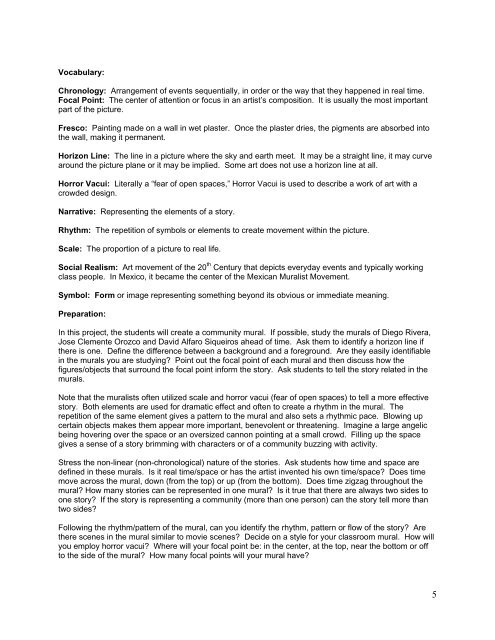Frida Kahlo - Faculty Web Pages
Frida Kahlo - Faculty Web Pages
Frida Kahlo - Faculty Web Pages
You also want an ePaper? Increase the reach of your titles
YUMPU automatically turns print PDFs into web optimized ePapers that Google loves.
Vocabulary:<br />
Chronology: Arrangement of events sequentially, in order or the way that they happened in real time.<br />
Focal Point: The center of attention or focus in an artist’s composition. It is usually the most important<br />
part of the picture.<br />
Fresco: Painting made on a wall in wet plaster. Once the plaster dries, the pigments are absorbed into<br />
the wall, making it permanent.<br />
Horizon Line: The line in a picture where the sky and earth meet. It may be a straight line, it may curve<br />
around the picture plane or it may be implied. Some art does not use a horizon line at all.<br />
Horror Vacui: Literally a “fear of open spaces,” Horror Vacui is used to describe a work of art with a<br />
crowded design.<br />
Narrative: Representing the elements of a story.<br />
Rhythm: The repetition of symbols or elements to create movement within the picture.<br />
Scale: The proportion of a picture to real life.<br />
Social Realism: Art movement of the 20 th Century that depicts everyday events and typically working<br />
class people. In Mexico, it became the center of the Mexican Muralist Movement.<br />
Symbol: Form or image representing something beyond its obvious or immediate meaning.<br />
Preparation:<br />
In this project, the students will create a community mural. If possible, study the murals of Diego Rivera,<br />
Jose Clemente Orozco and David Alfaro Siqueiros ahead of time. Ask them to identify a horizon line if<br />
there is one. Define the difference between a background and a foreground. Are they easily identifiable<br />
in the murals you are studying? Point out the focal point of each mural and then discuss how the<br />
figures/objects that surround the focal point inform the story. Ask students to tell the story related in the<br />
murals.<br />
Note that the muralists often utilized scale and horror vacui (fear of open spaces) to tell a more effective<br />
story. Both elements are used for dramatic effect and often to create a rhythm in the mural. The<br />
repetition of the same element gives a pattern to the mural and also sets a rhythmic pace. Blowing up<br />
certain objects makes them appear more important, benevolent or threatening. Imagine a large angelic<br />
being hovering over the space or an oversized cannon pointing at a small crowd. Filling up the space<br />
gives a sense of a story brimming with characters or of a community buzzing with activity.<br />
Stress the non-linear (non-chronological) nature of the stories. Ask students how time and space are<br />
defined in these murals. Is it real time/space or has the artist invented his own time/space? Does time<br />
move across the mural, down (from the top) or up (from the bottom). Does time zigzag throughout the<br />
mural? How many stories can be represented in one mural? Is it true that there are always two sides to<br />
one story? If the story is representing a community (more than one person) can the story tell more than<br />
two sides?<br />
Following the rhythm/pattern of the mural, can you identify the rhythm, pattern or flow of the story? Are<br />
there scenes in the mural similar to movie scenes? Decide on a style for your classroom mural. How will<br />
you employ horror vacui? Where will your focal point be: in the center, at the top, near the bottom or off<br />
to the side of the mural? How many focal points will your mural have?<br />
5


